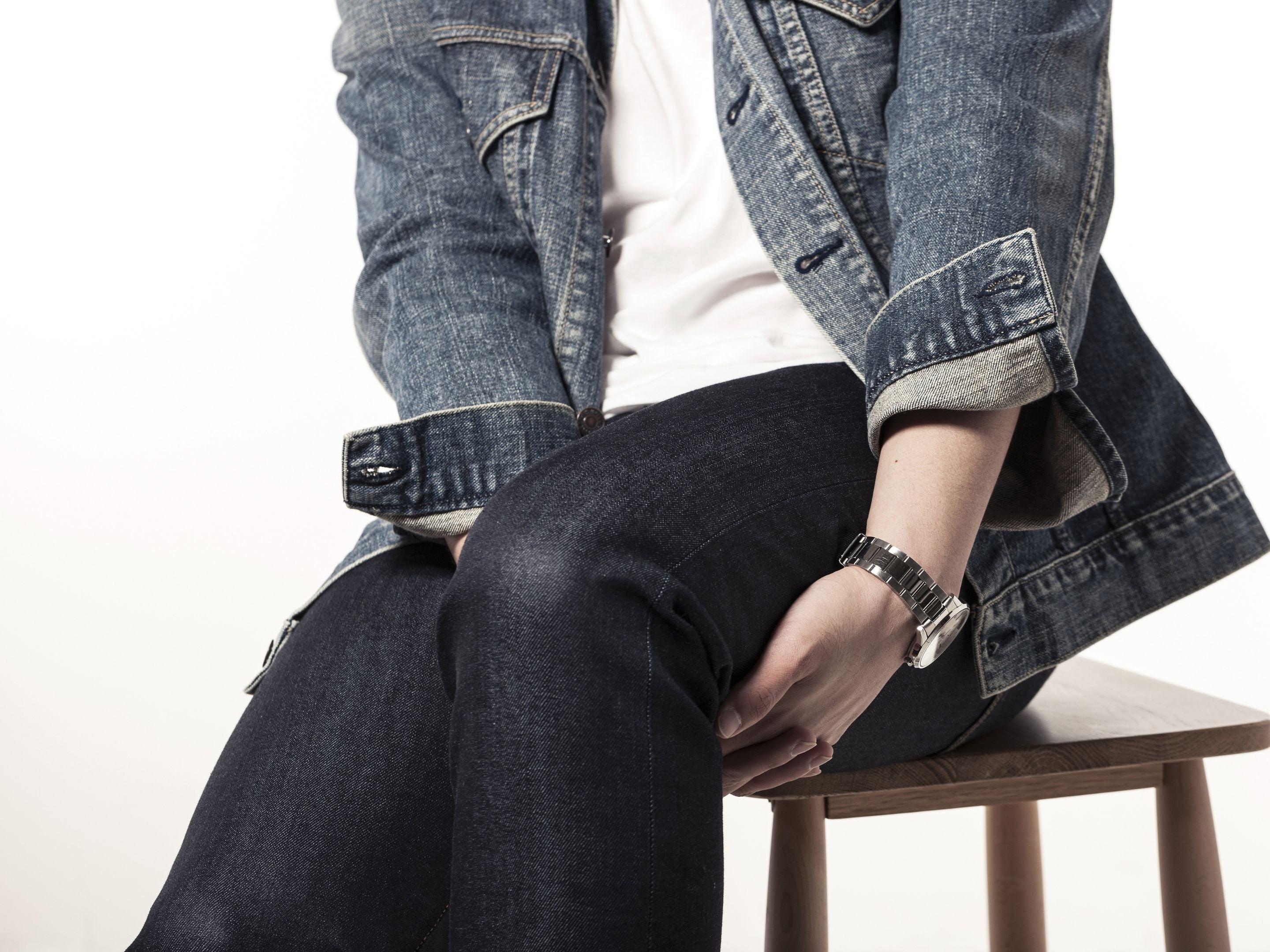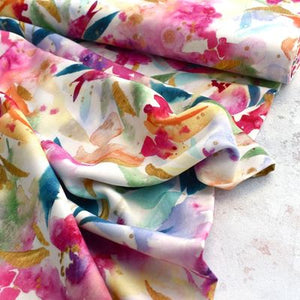Denim is a staple in almost every modern wardrobe and crafting a pair of perfectly fitting jeans is an Everest-type project most sewists hope to conquer in their sewing journey. But what is denim? And what does it mean to sew, wear, and enjoy having it in your handmade wardrobe? Here is a look at what makes denim fabric so special and why it is a treasured favorite!
Fabric Facts
Denim has been around since the mid-1800’s and was originally made for miners who needed durable garments that could withstand being worn for days on end. It made the leap from “practical” to “cool” about 100 years later when movie stars like Marilyn Monroe and James Dean were seen wearing jeans.

The classic twill weave provides its strength, while the iconic and familiar look of the fabric comes from its blue warp yarns woven with white weft yarns. These days, the highest quality denim is produced in Italy, Japan, the US, and Turkey. Though there are now countless colors and washes used, the classic indigo still reigns supreme. There are dozens of types of denim on the market, so we will highlight a few of the most commonly found here.
- Indigo—The indigo-dyed warp threads and white weft threads are tightly woven with the darker blue front-facing and the inside shown as a lighter blue.
- Stretch—As you may have guessed, this denim has a gentle give to it due to added spandex in the cotton yarn. The amount of stretch depends on the percentage of spandex and typically ranges from 10% to 30%. Hello, skinny jeans!
- Selvage—A non-stretch denim recognizable by its narrow width (usually around 30”) and unique finished edge. Since the edge is already finished, many jean-makers utilize it in side seams and pockets to show off little peeks of the finished edge. This type of denim a favorite from Japan and is often found in premium and high-end denim lines. Sew fancy!
- Raw—This can also be called “Dry” denim and has a rough, stiff texture which is often prized by denim enthusiasts and purists as they appreciate the way it will eventually conform to their bodies and the dye will wear over time. There are some that claim that this denim should never be washed and their overall care is still up for debate.
- Bull—Typically a heavier weight than others in this fabric family, it is 100% cotton with a 3x1 weaving pattern making it also among the most durable. As a result, Bull denim is often used for home decor fabric along with garments.
Sew Smart! Though denim comes in a wide variety of weights, the “sweet spot” for garments like jeans and overalls is somewhere between 8 oz. and 12 oz. Anything lower than 8 oz. is likely not going to hold up to the wear and tear put on jeans and anything over 12 oz. will probably be too heavy to feel comfortable and wear for any significant length of time.

Know Before You Sew
Pre-Wash—Always pre-wash and dry your denim before cutting into it (the only exception to the rule being raw denim). If your denim is a deep indigo, you may want to pre-washed it using a couple of cycles to help remove as much extra dye as possible. We also recommend pre-washing and drying your denim at a higher setting than you plan on washing your finished garment to help get the bulk of any shrinkage out of the way ahead of time. Although, your denim will likely still shrink a bit, especially in the length, in the next few washings.
Cutting—Due to its twill weave, denim garments tend to develop something called “leg twist”, so it is recommended that you cut at least the front and back pattern pieces individually. Also take care to make sure that they are mirrored in the same way they would be had you cut the fabric while folded.
Needles & Thread—Not surprisingly, it is recommended that denim is sewn with denim needles which have sharper points to more easily pierce multiple layers of the dense fabric. It is also helpful to have topstitching needles and thread on-hand as many garments call for topstitching and bartacks for reinforced strength. Denim is often sewn with matching all-purpose thread and a contrasting topstitching thread, such as the iconic gold found on Levis, and it’s a great opportunity to make a statement on your me-made garments!

Sewing & Pressing—Though denim can certainly be sewn entirely on a regular machine, its tendency to fray means that all edges need to be finished. We found this is easiest done with a serger, but a zig-zag stitch also works well. To get those professional-looking seams, become BFFs with your iron and steam away! A clapper and tailor’s ham also will go a long way in making this process much easier.
Sew Smart! Though not essential, there are a few tools that can make working with denim a bit easier. A hump jumper (or jean-a-ma-jig) will help you ease some of the bulkier seams through your sewing machine by elevating its foot. A hammer will assist you when attaching buttons and rivets or getting bulky seams a bit thinner for topstitching. And an awl is useful for poking holes for hardware!
TFC (Tender Fabric Care!)
How you care for your denim will go a long way in determining how long it lasts! After the time and effort you put into all of that topstitching and rivet-installing, those jeans, jackets, and boiler suits, you definitely want them to last a while.
The first rule of washing denim? Don’t! Well, at least not too often or you will find that your stretch denim will begin to lose its elasticity and that incredible conforms-exactly-to-your-curves broken-in fit on your non-stretch denim will not be the same after a trip through the washing machine.

When you do need to wash your jeans, wash them in cold water and avoid the dryer (particularly with stretch denim). If you have a dark indigo wash that you want to preserve, it is recommended that you wash them inside-out and add a cup of white vinegar. Be mindful that darker washes may still run even after the first wash or two, so it’s best to wash them on their own until you’re sure that’s not happening. Color catchers work great for this!
Speaking of darker washes, you will also want to be careful about other light colored materials they come in contact with. For example a white couch, hand bag, and even shoes, that might rub against the indigo and get some transfer.
What to Sew?
Denim is one of those fabrics that lends itself to an enormous array of possibilities because of the huge variety of weights and washes it comes in, along with the fact that it can be found in both stretch and non-stretch versions.
Some of our favorite traditional makes with denim include jeans, shorts, skirts, overalls, and jackets all well suited for heavier denims (8 to 12 oz.). With some of the lighter weight denim fabrics (4 to 7 oz) you can also construct classic looks like shirts, jumpsuits, and dresses.

Denim’s sturdy properties also allows it to lend itself well to accessories like aprons, hats, and bags. Add to that a ton of home decor projects like pillows, pet beds, and floor poufs, and you can see why this is among the most popular fabrics to work with!
Sew Smart! Always check the recommended fabric weight and hardware needed for the pattern or project you’re working on to make sure that you’ve chosen something appropriate for your make and that you have the necessary tools on-hand.
Sew Much More
Distressing—Perhaps you’re a bit impatient for that worn-in appearance which comes after months and years of wear and tear. You can achieve this look on even brand new jeans through a variety of distressing techniques. Try using a fine grit sandpaper along some of the seams, like the pockets and belt loops, for that aged look.
Love the ripped denim trend? Cut a small hole in the fabric and then sand along it's edges to create a bit more fraying. Using a seam ripper or a pair of tweezers can also assist you in gently coaxing out some of the white weft threads.
Not loving the deep indigo color? A diluted bleach bath can help lighten the color and is another technique used to give denim a well-worn look before its time. It's best to experiment with scraps first to find the perfect water to bleach ration and amount of time in the bath.

Repairs—Sometimes, your well-loved denim can become a little too distressed or you find you’ve developed holes in all the wrong areas to the point that it becomes, well, distressing. Luckily, there are many routes to take to mend and repair your denim that are quite creative and beautiful works of art in their own right.
For a repair that you’d like to have blend in, try to find another scrap of denim in a similar weight and shade to use as a patch behind the hole or tear. Stitch back and forth over the hole to secure the patch and prevent it from tearing further. Note, be sure to use thread that is also a close match to original denim as possible.
For something a bit more fun, you could use a contrasting denim color, or different scrap of fabric, or even a cool iron-on patch to cover the area. Add a bit of embroidery or hand stitching for even more interest and make your denim garment uniquely yours!
We SEW Want To Know What You Think! What is your favorite denim make to-date? What are you hoping to make next? Let us know in the comments!







Hi, Is cotton denim the same as cotton twill ? I also, noticed there’s brushed/sanded twill and denim how does the manufacture make the brushed fabric? Last, will you be offering the brushed twill for making pants and jackets for Fall? Thank you so much,
Leave a comment